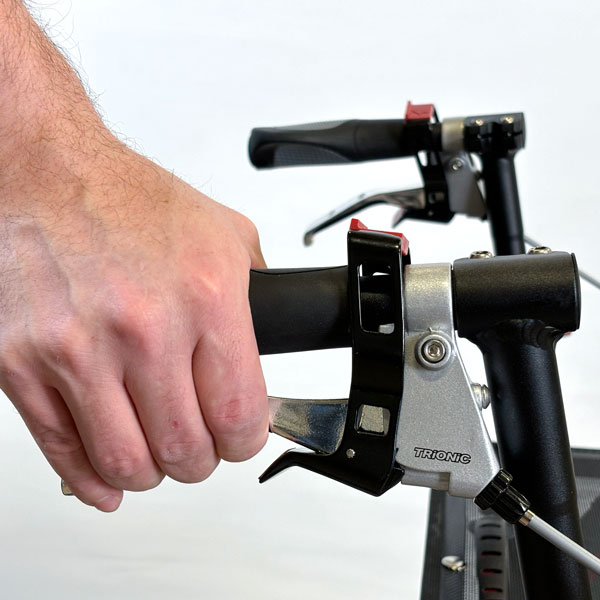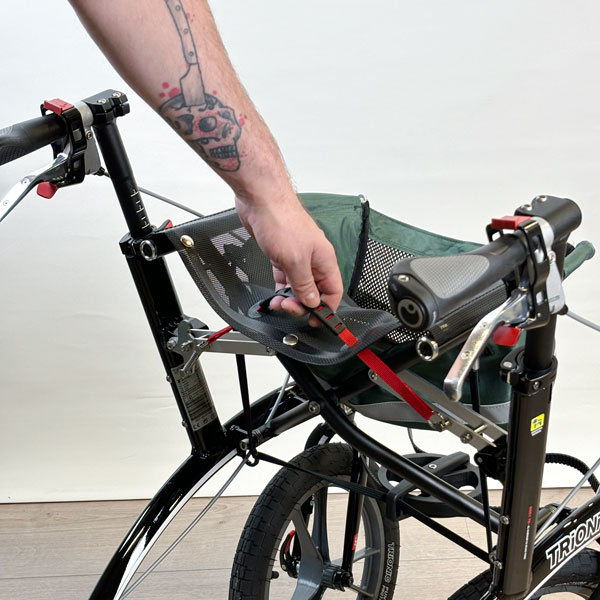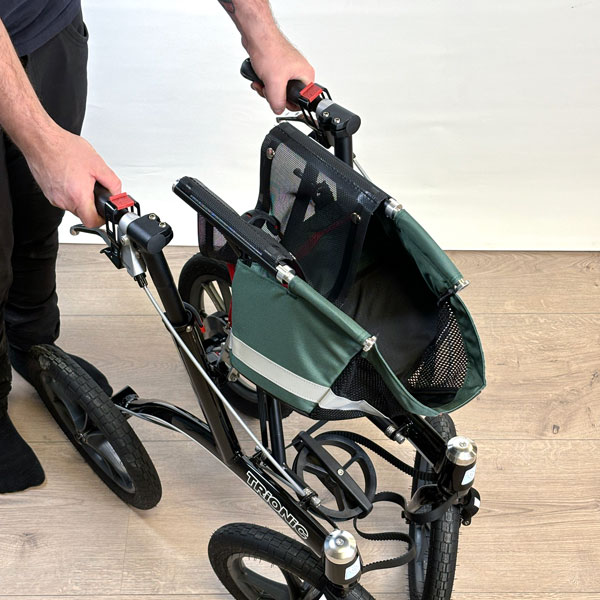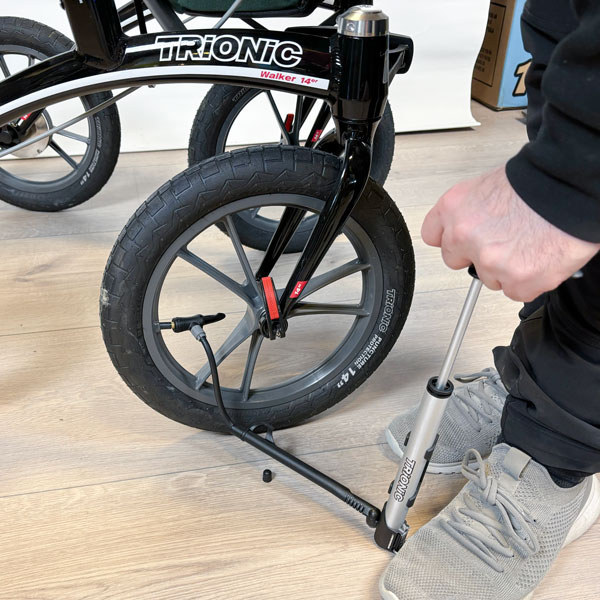Walker User Guide
Trionic Walker〈〈
The Rollator Walker 9er is your perfect rollator to use both indoors and outdoors. With its 9” wheels and extra-soft PU-tires you’ll enjoy high comfort and a well-balanced performance. The Walker 12er is your faithful companion when you are heading outdoors. Its 12” wheels and air-filled tires guarantee a very comfortable ride, and it’s perfect for every urban and outdoor area. The Trionic Walker 14er is the world’s first rollator with 14” big wheels. All the new Trionic Walker rollators are equipped with a synchronized steering feature that eliminates the problems with shimmying and skewed swivel wheels.
The Walkers are tested and approved according to the international standard ISO-11199-2:2005, for a maximum user weight of 150 kg.
Technical Data 〈〈
| Walker 9er M | Walker 12er S | Walker 12er M/L | Walker 14er M/L | |
|---|---|---|---|---|
| Min. height: | 74 cm | 71 cm | 76 cm | 81 cm |
| Max. height: | 94 cm | 86 cm | 96 cm | 100 cm |
| Width: | 66 cm | 69 cm | 69 cm | 69 cm |
| Length: | 68 cm | 81 cm | 81 cm | 85 cm |
| Seat height: | 62 cm | 56 cm | 62 cm | 62 cm |
| Seat width: | 43 cm | 46 cm | 46 cm | 46 cm |
| Wheel size: | 9"/23 cm | 12"/31 cm | 12"/31 cm | 14"/36 cm |
| Size folded H x L x W | L68xW28xH82 cm | L81xW28xH88 cm | L81xW28xH88 cm | L85xW28xH90 cm |
| Size folded without wheels H x L x W: | L61xW28xH74 cm | L67xW28xH76 cm | L67xW28xH76 cm | L67xW28xH76 cm |
| Weight: | 9,5 kg | 9,1 kg | 9,2 kg | 9,9 kg |
| Weight without wheels: | 6,6 kg | 6,4 kg | 6,5 kg | 6,6 kg |
| Max. user weight: | 150 kg | 150 kg | 150 kg | 150 kg |
Safety〈〈
- Both brakes should be locked in parking mode before you use the seat.
- Before you start walking with the Walker, make sure it’s completely unfolded.
- Be extra careful in steep terrain and on slanting ground.
- The stability of the Veloped is tested with a basket load of 5 kg. If you load additional weight to the basket, make sure to distribute the weight evenly in the basket.
Correct Grip Height〈〈

How to set the correct height of your rollator
Many rollator users set the grips too high, thinking that it will promote a more upright posture. But this actually worsens the posture, and it affects the stability negatively.
You can determine the correct grip height by doing as follows, as recommended by all physiotherapists and all rollator manufacturers:
- Stand upright with your back as straight as possible, with your shoes on and with your arms hanging in a relaxed state along your body (elbow slightly bent).
- Measure the vertical distance from the floor to the wrist bone = recommended grip height.
With the grips at wrist height:
- You do not have to raise your shoulders, and you can unload a greater part of your body weight.
- You can walk closer to the hand grips, which results in a more upright body posture.
- A more vertical weight distribution (downwards) improves both the stability and the brake performance.
First Time Use 〈〈
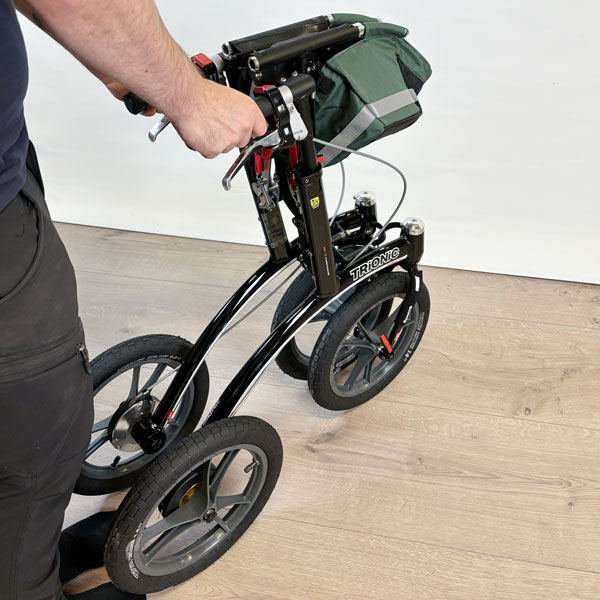
1. To unfold the Walker, pull the two hand grips away from each other.
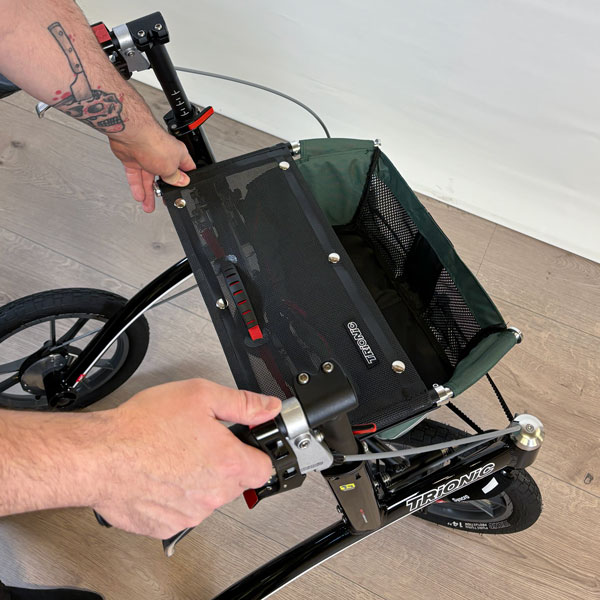
2. Grab the right grip with your right hand and lift the right front- and right rear wheel off the ground. With the right wheels lifted, lock the Walker in Walking mode by pressing the left rear corner of the seat distinctly downwards. You should hear a “click” when the Walker locks into walking mode.

3. Before using the walker, make sure that the unfolding mechanism has locked securely in place.
NOTE: It is important that you lift the right wheels off the ground, so that the right front wheel freely can turn into its aligned position.

4. Open the quick-release levers and adjust the grip height as described on page 7 in the chapter “Grip Height Adjustment”.
Parking Brake 〈〈
You can engage the parking brake in 3 different ways.
Option 1: Push the lower red parking trigger downwards with your index finger, while you pull the brake lever at the same time. Make sure that the parking brake is engaged, and that the Walker does not move.
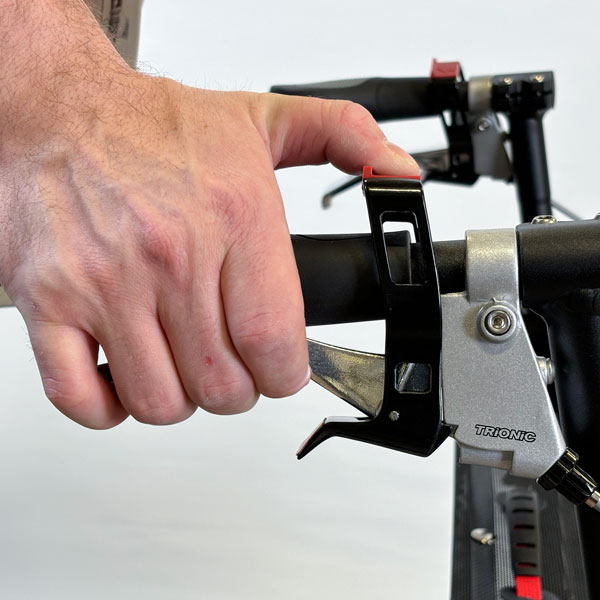
Option 2: Pull the upper red parking trigger rearwards with your thumb, while you pull the brake lever at the same time. Make sure that the parking brake is engaged.
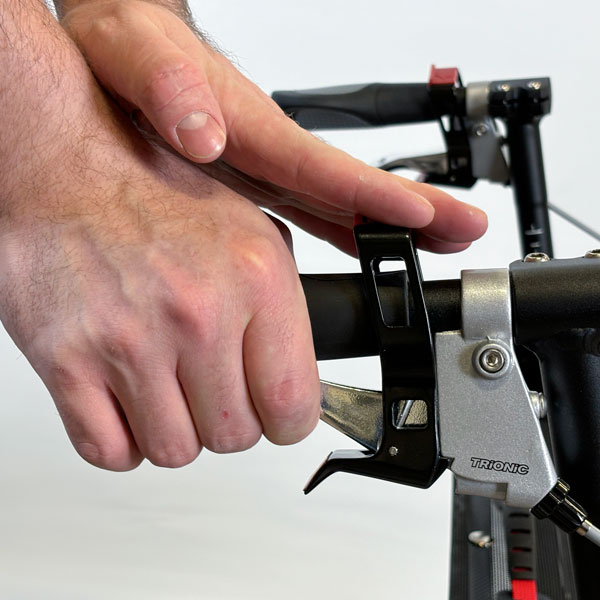
Option 3: Use both hands. Pull the upper red parking trigger rearwards with one hand, while you pull the brake lever with your other hand. Make sure that the parking brake is engaged.
To release the parking brake, brake in the same manner as for using the motion brake.
Grip Height Adjustment 〈〈
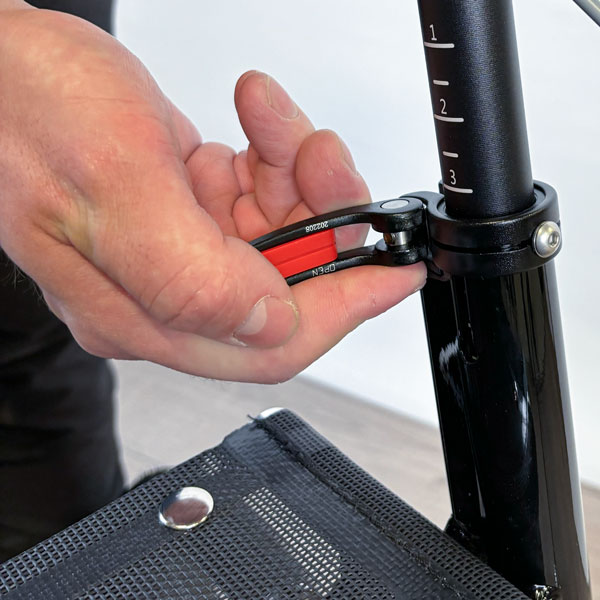
1. Release the quick-release lever positioned just above the seat by folding it outwards horizontally.
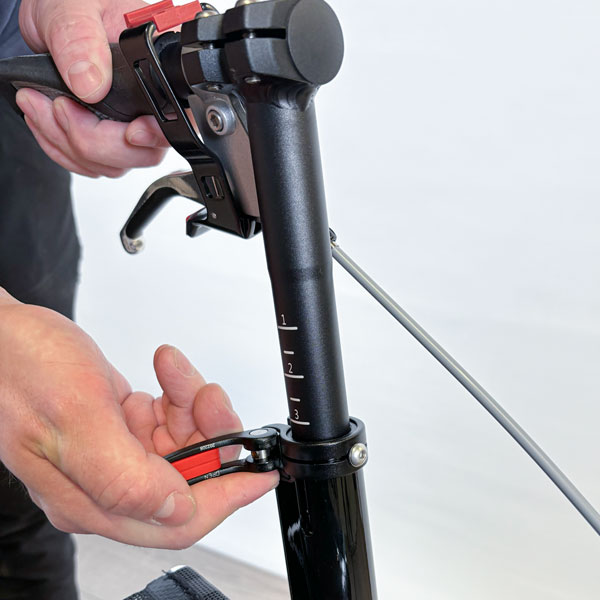
2. Slide the hand grip up-/downwards to your preferred grip height.

3. Lock the hand grip at the chosen height by folding the quick-release lever to its closed position.
NOTE: Do not operate the quick-release levers like wing nuts or screws.
Grip Angle Adjustment 〈〈
The angle of the grips can be adjusted so that you get a comfortable hand position and an optimal support.
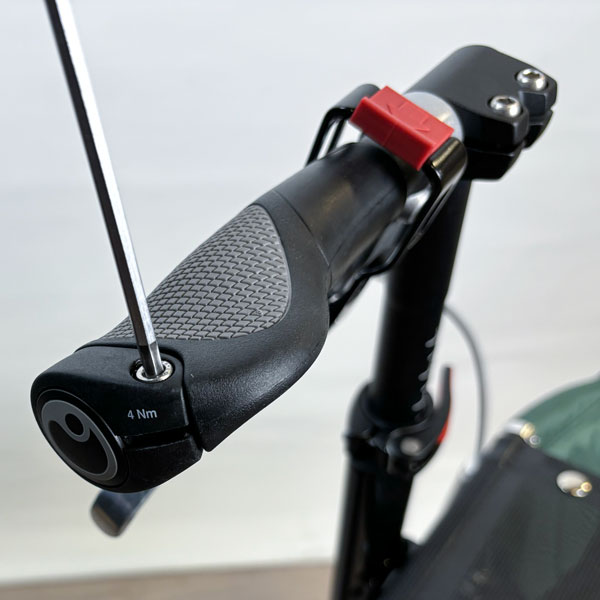
1. Loosen the screw on the rear end of the grip with a 4 mm Allen key.

2. Turn/rotate the grip to your chosen angle, and lock it in place by tightening the screw again.
Unfolding the Walker 〈〈
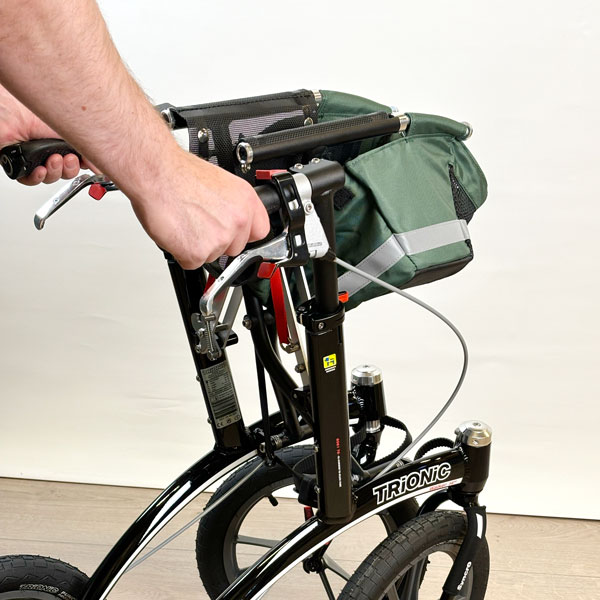
1. To unfold the Walker, pull the two hand grips away from each other.
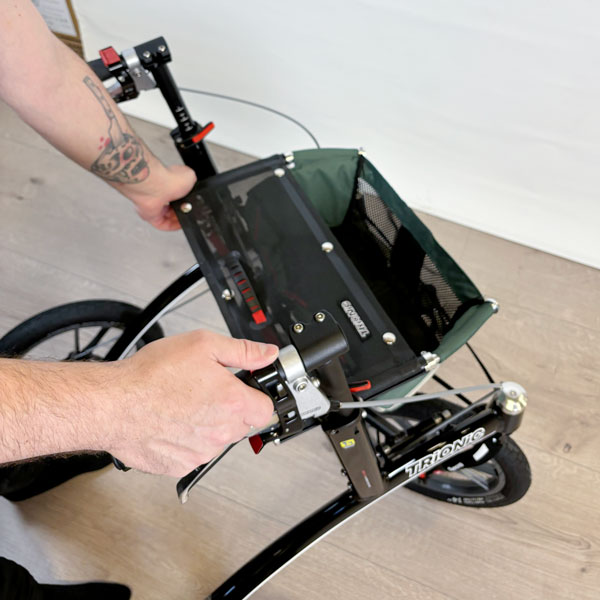
2.Grab the right grip with your right hand and lift the right front- and right rear wheel off the ground. With the right wheels lifted, lock the Walker in Walking mode by pressing the left rear corner of the seat distinctly downwards. You should hear a “click” when the Walker locks into walking mode.

3. Before using the Walker, make sure that the unfolding mechanism has locked securely in place.
NOTE: It is important that you lift the right wheels off the ground, so that the right front wheel freely can turn into its aligned position.
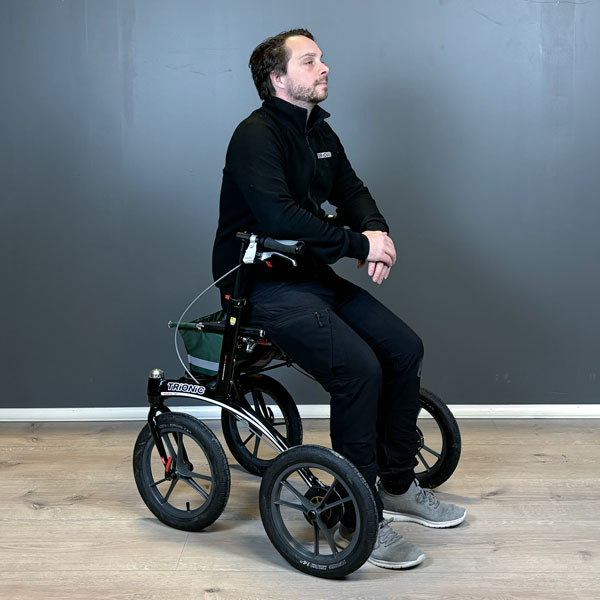
NOTE! Always engage both parking brakes before you use the seat.
Detaching the Front Wheels 〈〈

1. Open the quick-release on the front wheel by folding it outwards.

2. Unscrew the nut on the inside of the fork a bit, so that the wheel can be detached from the fork.

3. Remove the front wheel from the fork.

4. NOTE: Do not operate the quick-release levers like wing nuts or screws.
Attaching the Front Wheels 〈〈

1. Enter the front wheel into the fork, with the quick-release lever positioned on the outside of the Walker.

2. Tighten the nut on the inside of the fork, so that the quick-release gets correctly tensioned when closed.

3. Close the quick-release on the front wheel by folding it inwards. Make sure that the quick-release lever is correctly closed, preferably in a position behind the fork when seen in the traveling direction of the Walker.

4. NOTE: Do not operate the quick-release levers like wing nuts or screws.
Removing/Installing the Rear Wheels 〈〈
The rear wheels are removable to simplify transportation of the Walker.
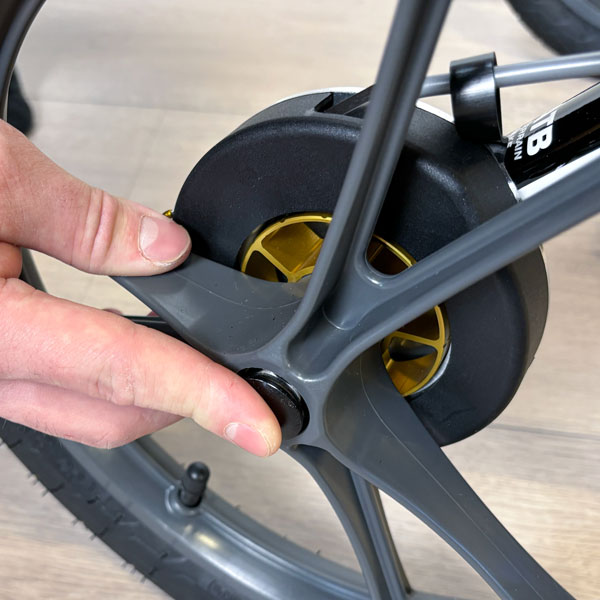
1. To detach the wheel, press the black button at the centre of the wheel and pull the wheel off.

2. To attach the wheel, press the black button at the centre of the wheel and push the wheel axle into the axle hole. Release the button when the axle is in its end position.
3. Hold the tire and push/pull the wheel back and forth laterally to check if the wheel is properly secured.
Brake Adjustment 〈〈

1. If the brakes works poorly, loosen the adjustment screw on each brake lever (counter-clockwise) and lock it in position by screwing the lock-nut towards the handle (clockwise).

Contact your retailer, or the person responsible for servicing your Trionic Walker, if the brakes still work poorly.
Safety Instructions〈〈
Before use, check that your Trionic Walker functions properly:
- Check the function of the motion and parking brakes.
- Make sure that the frame is locked in unfolded walking mode.
- Check that the grips is properly secured at the correct height.
- The user’s weight may not exceed 150 kg.
- An annual control of the product is recommended to ensure its function, either by your dealer or service representative authorized by Trionic.
- Do not use a defective Trionic Walker.
Service Instructions 〈〈
In order to maintain function and safety, make sure the following is carried out regularly:
- Clean the Walker with normal dish washing liquid, water and a dishcloth. Make sure it’s properly dried.
- Keep the wheels clean with dish washing liquid, water and a plastic brush.
- Check that screws and levers are tightened properly.
- If your Walker is not in perfect condition: please immediately contact your retailer/dealer or service representative authorized to service your Trionic Walker.
Make sure to check the tyre pressure every 4–5 weeks. Trionic recommends a tyre pressure of 1.5 bar/22 psi.
Trionic does not take responsibility for any alterations (adjustments or inadequate repairs) done to the product without prior authorization.
Guarantee 〈〈

 CE – Trionic Sverige AB ensures that this Class I Medical Device meets the requirements of the EU regulation MDR 2017/745 and that it is certified to ISO 11199-2:2021.
CE – Trionic Sverige AB ensures that this Class I Medical Device meets the requirements of the EU regulation MDR 2017/745 and that it is certified to ISO 11199-2:2021.
Label
The Veloped is tested and approved according to the international standard for rollators ISO 11199-2:2021 and it meets the requirements of the EU regulation for medical devices MDR 2017/745.
The user’s weight may not exceed 150 kg.
- Product name
- Max user weight
- Length
- Width
- Max. and min. height
- Manufacturing Date
- UDI/Digital Product Passport: GS1 QR-code (AIDC/HRI)
- Serial number
- Article Number
- Rollator certified to ISO 11199-2:2021
- Read the manual before use.
- Product Code: GTIN13
- Manufacturer
- CE mark
- Environmentally Friendly
- Medical Device
- Aid approved according to MDR 2017/745

Environmentally Friendly 〈〈
The Trionic Walker is manufactured in the way to have as little negative impact on the environment as possible during its lifecycle. When the product has served its purpose it can be scrapped and the parts can be recycled.

- The product’s aluminium components are separated from the remaining parts when sorted for recycling. The parts are sorted into metal, plastic and mixed materials.
- The greater part of the product is made of aluminium, steel and plastic.
- Examples of components made of mixed materials are the brake levers, wheels and gripbar.
- If you are uncertain of how to handle the recyclable material, please contact your local authorities, as different municipalities/recycling companies follow different recycling methods.
Trionic Sverige AB is a member of Repak Ltd Ireland and Valpak Limited in UK and fully implements the European Directive on Packaging and Packaging Waste dated December 20, 1994.
